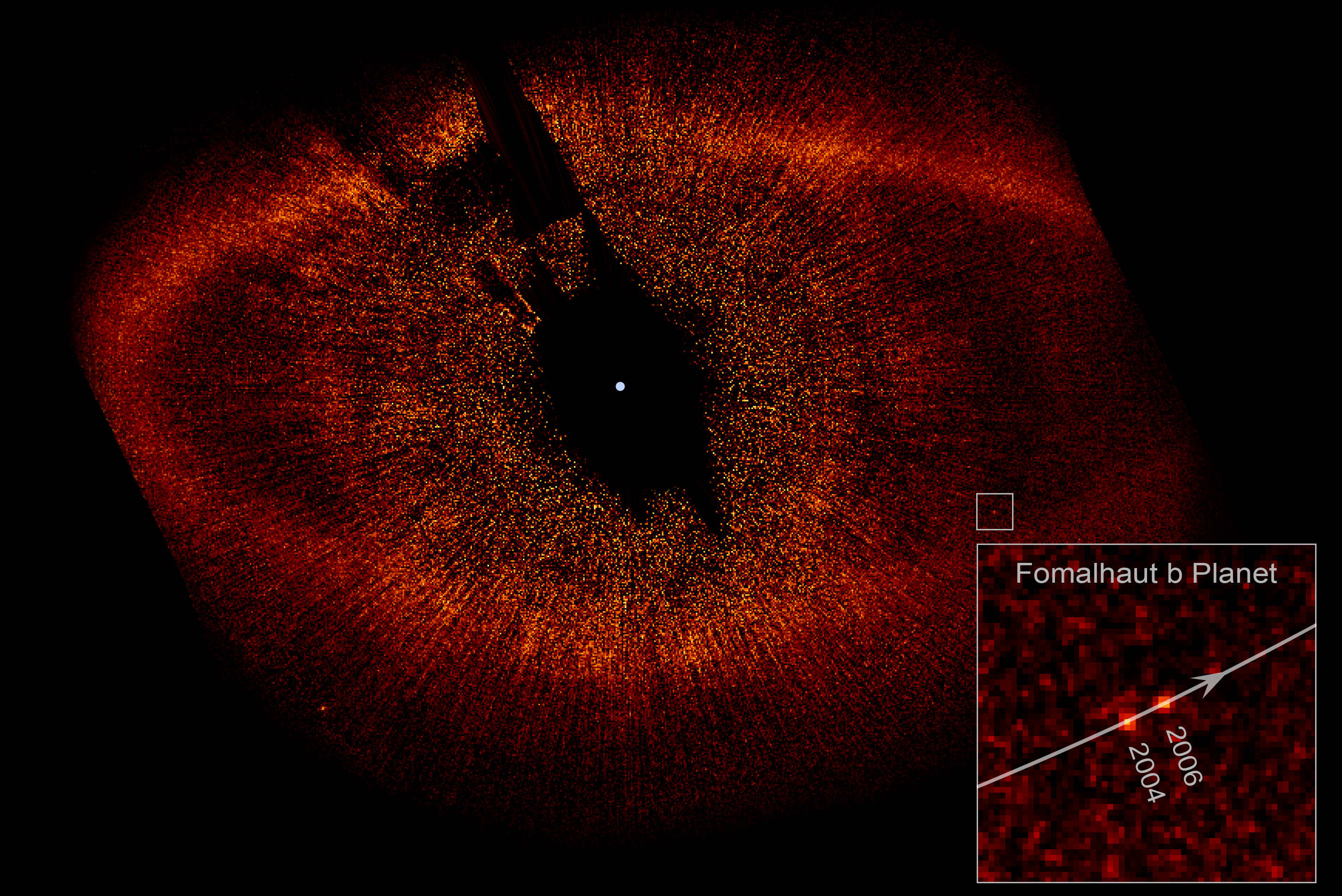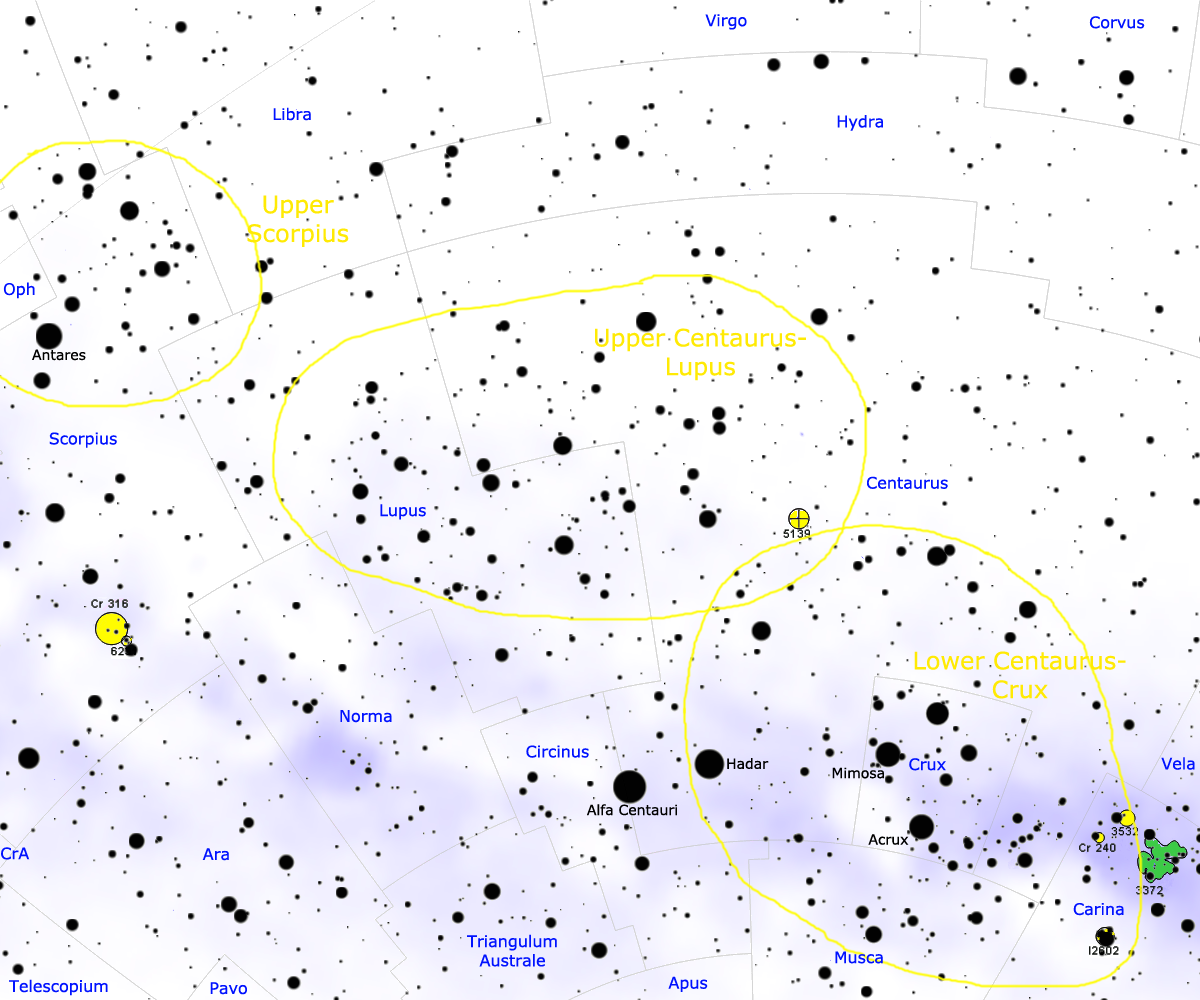|
HD 106906 B
HD 106906 b is a directly imaged planetary-mass companion and candidate exoplanet orbiting the star , in the constellation Crux at about from Earth. It is estimated to be about eleven times the mass of Jupiter and is located about 738 AU away from its host star. is rare in astronomy; while its mass estimate is nominally consistent with identifying it as an exoplanet, it appears at a much wider separation from its parent star than thought possible for in-situ formation from a protoplanetary disk. Description is the only known companion orbiting , a spectroscopic binary star composed of two F5V main-sequence stars with a combined mass of . Based on the star's luminosity and temperature, the system is estimated to be about . The system is a likely member of the Scorpius–Centaurus association. The star is surrounded by a debris disk oriented 21 degrees away from ; this disk is about from the binary on its interior and ranges asymmetrically from approximately from the ... [...More Info...] [...Related Items...] OR: [Wikipedia] [Google] [Baidu] |
The Astronomical Journal
''The Astronomical Journal'' (often abbreviated ''AJ'' in scientific papers and references) is a peer-reviewed monthly scientific journal owned by the American Astronomical Society (AAS) and currently published by IOP Publishing. It is one of the premier journals for astronomy in the world. Until 2008, the journal was published by the University of Chicago Press on behalf of the AAS. The reasons for the change to the IOP were given by the society as the desire of the University of Chicago Press to revise its financial arrangement and their plans to change from the particular software that had been developed in-house. The other two publications of the society, the ''Astrophysical Journal'' and its supplement series, followed in January 2009. The journal was established in 1849 by Benjamin A. Gould. It ceased publication in 1861 due to the American Civil War, but resumed in 1885. Between 1909 and 1941 the journal was edited in Albany, New York. In 1941, editor Benjamin Boss arrange ... [...More Info...] [...Related Items...] OR: [Wikipedia] [Google] [Baidu] |
Projected Separation
This glossary of astronomy is a list of definitions of terms and concepts relevant to astronomy and cosmology, their sub-disciplines, and related fields. Astronomy is concerned with the study of celestial objects and phenomena that originate outside the atmosphere of Earth. The field of astronomy features an extensive vocabulary and a significant amount of jargon. A B C D E F G H I J K L ... [...More Info...] [...Related Items...] OR: [Wikipedia] [Google] [Baidu] |
1RXS J160929
1RXS is an acronym which is the prefix used for the First ROSAT X-ray Survey (1st ROSAT X-ray Survey). This is a catalogue of astronomical objects that were visible in the X-ray spectrum from the ROSAT satellite, in the field of X-ray astronomy. Examinations of 1RXS has shown that many sources can be identified, such as old neutron star A neutron star is the collapsed core of a massive supergiant star, which had a total mass of between 10 and 25 solar masses, possibly more if the star was especially metal-rich. Except for black holes and some hypothetical objects (e.g. w ...s, while other entries are "intriguing", according to one researcher. See also * 1RXS J160929.1−210524, example References External links Catalog site Astronomical surveys X-ray astronomy ROSAT objects {{spacecraft-stub ... [...More Info...] [...Related Items...] OR: [Wikipedia] [Google] [Baidu] |
Beta Pictoris
Beta Pictoris (abbreviated β Pictoris or β Pic) is the second brightest star in the constellation Pictor. It is located from the Solar System, and is 1.75 times as massive and 8.7 times as luminous as the Sun. The Beta Pictoris system is very young, only 20 to 26 million years old, although it is already in the main sequence stage of its evolution. Beta Pictoris is the title member of the Beta Pictoris moving group, an association of young stars which share the same motion through space and have the same age. The European Southern Observatory (ESO) has confirmed the presence of two planets, Beta Pictoris b, and Beta Pictoris c, through the use of direct imagery. Both planets are orbiting in the plane of the debris disk surrounding the star. Beta Pictoris c is currently the closest extrasolar planet to its star ever photographed: the observed separation is roughly the same as the distance between the asteroid belt and the Sun. Beta Pictoris shows an excess of ... [...More Info...] [...Related Items...] OR: [Wikipedia] [Google] [Baidu] |
Near-infrared Spectroscopy
Near-infrared spectroscopy (NIRS) is a spectroscopic method that uses the near-infrared region of the electromagnetic spectrum (from 780 nm to 2500 nm). Typical applications include medical and physiological diagnostics and research including blood sugar, pulse oximetry, functional neuroimaging, sports medicine, elite sports training, ergonomics, rehabilitation, neonatal research, brain computer interface, urology (bladder contraction), and neurology (neurovascular coupling). There are also applications in other areas as well such as pharmaceutical, food and agrochemical quality control, atmospheric chemistry, combustion research and astronomy. Theory Near-infrared spectroscopy is based on molecular overtone and combination vibrations. Such transitions are forbidden by the selection rules of quantum mechanics. As a result, the molar absorptivity in the near-IR region is typically quite small. (NIR absorption bands are typically 10–100 times weaker than the ... [...More Info...] [...Related Items...] OR: [Wikipedia] [Google] [Baidu] |
The Astrophysical Journal
''The Astrophysical Journal'', often abbreviated ''ApJ'' (pronounced "ap jay") in references and speech, is a peer-reviewed scientific journal of astrophysics and astronomy, established in 1895 by American astronomers George Ellery Hale and James Edward Keeler. The journal discontinued its print edition and became an electronic-only journal in 2015. Since 1953 ''The Astrophysical Journal Supplement Series'' (''ApJS'') has been published in conjunction with ''The Astrophysical Journal'', with generally longer articles to supplement the material in the journal. It publishes six volumes per year, with two 280-page issues per volume. ''The Astrophysical Journal Letters'' (''ApJL''), established in 1967 by Subrahmanyan Chandrasekhar as Part 2 of ''The Astrophysical Journal'', is now a separate journal focusing on the rapid publication of high-impact astronomical research. The three journals were published by the University of Chicago Press for the American Astronomical Society u ... [...More Info...] [...Related Items...] OR: [Wikipedia] [Google] [Baidu] |
Debris Disk
A debris disk (American English), or debris disc (Commonwealth English), is a circumstellar disk of dust and debris in orbit around a star. Sometimes these disks contain prominent rings, as seen in the image of Fomalhaut on the right. Debris disks are found around stars with mature planetary systems, including at least one debris disk in orbit around an evolved neutron star. Debris disks can also be produced and maintained as the remnants of collisions between planetesimals, otherwise known as asteroids and comets. By 2001, more than 900 candidate stars had been found to possess a debris disk. They are usually discovered by examining the star system in infrared light and looking for an excess of radiation beyond that emitted by the star. This excess is inferred to be radiation from the star that has been absorbed by the dust in the disk, then re-radiated away as infrared energy. Debris disks are often described as massive analogs to the debris in the Solar System. Most known d ... [...More Info...] [...Related Items...] OR: [Wikipedia] [Google] [Baidu] |
Scorpius–Centaurus Association
The Scorpius–Centaurus association (sometimes called Sco–Cen or Sco OB2) is the nearest OB association to the Sun. This stellar association is composed of three subgroups (Upper Scorpius, Upper Centaurus–Lupus, and Lower Centaurus–Crux) and its distance is about 130 parsecs or 420 light-years. Using improved Hipparcos data, Rizzuto and colleagues analysed nearby stars more closely, bringing the number of known members to 436. They doubt the need to add a subclassification because they found a more continuous spread of stars. The Sco–Cen subgroups range in age from 11 million years (Upper Scorpius) to roughly 15 million years (Upper Centaurus–Lupus and Lower Centaurus–Crux). Many of the bright stars in the constellations Scorpius, Lupus, Centaurus, and Crux are members of the Sco–Cen association, including Antares (the most massive member of Upper Scorpius), and most of the stars in the Southern Cross. Hundreds of stars have been identified as members of Sc ... [...More Info...] [...Related Items...] OR: [Wikipedia] [Google] [Baidu] |
Main-sequence Star
In astronomy, the main sequence is a continuous and distinctive band of stars that appears on plots of stellar color versus brightness. These color-magnitude plots are known as Hertzsprung–Russell diagrams after their co-developers, Ejnar Hertzsprung and Henry Norris Russell. Stars on this band are known as main-sequence stars or dwarf stars. These are the most numerous true stars in the universe and include the Sun. After condensation and ignition of a star, it generates thermal energy in its dense core region through nuclear fusion of hydrogen into helium. During this stage of the star's lifetime, it is located on the main sequence at a position determined primarily by its mass but also based on its chemical composition and age. The cores of main-sequence stars are in hydrostatic equilibrium, where outward thermal pressure from the hot core is balanced by the inward pressure of gravitational collapse from the overlying layers. The strong dependence of the rate of energy ... [...More Info...] [...Related Items...] OR: [Wikipedia] [Google] [Baidu] |
F-type Main-sequence Star
An F-type main-sequence star (F V) is a main-sequence, hydrogen-fusing star of spectral type F and luminosity class V. These stars have from 1.0 to 1.4 times the mass of the Sun and surface temperatures between 6,000 and 7,600 K.Tables VII and VIII. This temperature range gives the F-type stars a whitish hue when observed by the atmosphere. Because a main-sequence star is referred to as a dwarf star, this class of star may also be termed a yellow-white dwarf (not to be confused with white dwarfs, remnant stars that are a possible final stage of stellar evolution). Notable examples include Procyon A, Gamma Virginis A and B, and KIC 8462852. Spectral standard stars The revised Yerkes Atlas system (Johnson & Morgan 1953) listed a dense grid of F-type dwarf spectral standard stars; however, not all of these have survived to this day as stable standards. The ''anchor points'' of the MK spectral classification system among the F-type main-sequence dwarf stars, i.e. those ... [...More Info...] [...Related Items...] OR: [Wikipedia] [Google] [Baidu] |
Spectroscopic Binary
A binary star is a system of two stars that are gravitationally bound to and in orbit around each other. Binary stars in the night sky that are seen as a single object to the naked eye are often resolved using a telescope as separate stars, in which case they are called ''visual binaries''. Many visual binaries have long orbital periods of several centuries or millennia and therefore have orbits which are uncertain or poorly known. They may also be detected by indirect techniques, such as spectroscopy (''spectroscopic binaries'') or astrometry (''astrometric binaries''). If a binary star happens to orbit in a plane along our line of sight, its components will eclipse and transit each other; these pairs are called ''eclipsing binaries'', or, together with other binaries that change brightness as they orbit, ''photometric binaries''. If components in binary star systems are close enough they can gravitationally distort their mutual outer stellar atmospheres. In some cases, ... [...More Info...] [...Related Items...] OR: [Wikipedia] [Google] [Baidu] |






